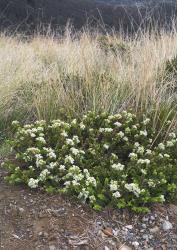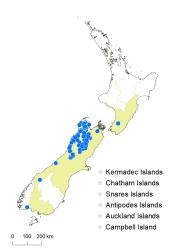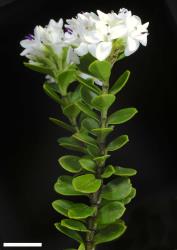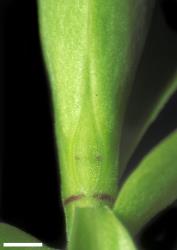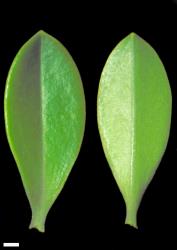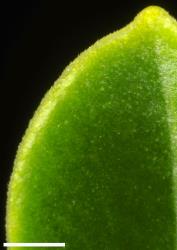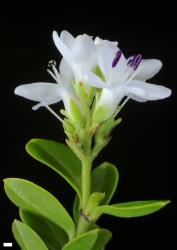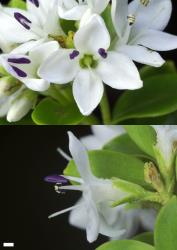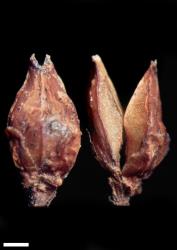- ≡ Hebe vernicosa var. canterburiensis (J.B.Armstr.) Cockayne & Allan, Trans. New Zealand Inst. 57: 30 (1926)
- ≡ Hebe canterburiensis (J.B.Armstr.) L.B.Moore in Allan, Fl. New Zealand 1, 899 (1961)
Open spreading shrub to 1 m tall. Stems obliquely ascending or decumbent to spreading, eglandular-pubescent; hairs usually uniform, rarely bifarious. Leaf bud distinct, its outer leaves appressed at margins until fully grown; sinus acute. Leaves sub-distichous, erecto-patent to spreading, narrow to broad, tapering; lamina coriaceous to rigid, ovate to elliptic to obovate, 8.0–18.5 mm long, 3.2–7.8 mm wide, usually glossy or rarely dull green to dark green above, dull green beneath; midrib evident; surfaces with short, eglandular hairs along midrib above; margin ciliolate, especially on young leaves, entire; apex obtuse to sub-acute, weakly and broadly plicate-acuminate; base cuneate or rarely more or less truncate; petiole 1–3 mm long. Inflorescence a lateral raceme, 11–30 mm long; flowers crowded, 5–12 per inflorescence, all bisexual; bracts alternate, or the lower ones opposite-decussate, ovate to elliptic or deltoid, > pedicels; pedicels erecto-patent, 0–4 mm long, eglandular-hairy all around. Calyx lobes 4, obtuse to sub-acute, or rarely acute, 1.8–3.1 mm long, sub-equal, mixed glandular- and eglandular-ciliolate. Corolla 7–12 mm diameter; tube white, 1.4–3.5 mm long, ≥ calyx, glabrous; lobes 4, white, sometimes pink in bud, erecto-patent to recurved, sub-equal to unequal, elliptic, ovate, obovate, or orbicular, 3.5–4.2 mm long, obtuse to rounded; nectar guides absent. Stamen filaments white, 3–5 mm long; anthers purple. Style glabrous, 3.5–7.2 mm long. Capsules latiseptate, acute to sub-acute, glabrous, 2.6–4.9 mm long, 2.1–3.8 mm at widest point. Seeds ellipsoid to discoid, flattened, smooth, brown, 1.3–1.7 mm long.
V. canterburiensis has a similar habit, and sometimes habitat, to V. vernicosa, and they can be confused. Often, but by no means always, plants of V. canterburiensis have dense, short hairs on the backs of the petioles, whereas V. vernicosa plants are glabrous there (but hairy along the edges). Otherwise the most reliable differences to distinguish plants of V. vernicosa are their short and rounded calyx lobes (1.0–1.5 mm long), shorter corolla tubes (< calyx), tapering and often erecto-patent corolla lobes, pale pink anthers, and capsules that are about three times as long as the calyx (two times or less in V. canterburiensis).
V. societatis plants are also similar in growth form, but their leaves are glaucous. V. societatis is found only on Mt Murchison, Braeburn Range, from where V. canterburiensis is also known.
Plants with a more erect growth form than usual can look similar to V. odora, but V. odora leaves are abruptly narrowed to the petiole, and inflorescences are terminal, with sessile opposite flowers with narrow corolla lobes.
North Island: Mt Holdsworth (Tararua Range) only.
South Island: Western Nelson, Sounds Nelson (isolated localities in the Richmond Range), Marlborough (western parts), North Canterbury (north-western parts), Westland (south to Arawata River headwaters), Southland (Hump Ridge).
Montane southern beech forest at or near tree line, sub-alpine grassland and shrubland. Recorded elevations range from 548 to 1492 m.
Flowers: October–April; fruits: November–April, persisting all year.
2n = 40 (see Bayly & Kellow 2006, as Hebe canterburiensis).
Veronica canterburiensis is classified in V. subg. Pseudoveronica sect. Hebe and the informal group “Apertae” (small-leaved) (Albach & Meudt 2010; Bayly & Kellow 2006).



